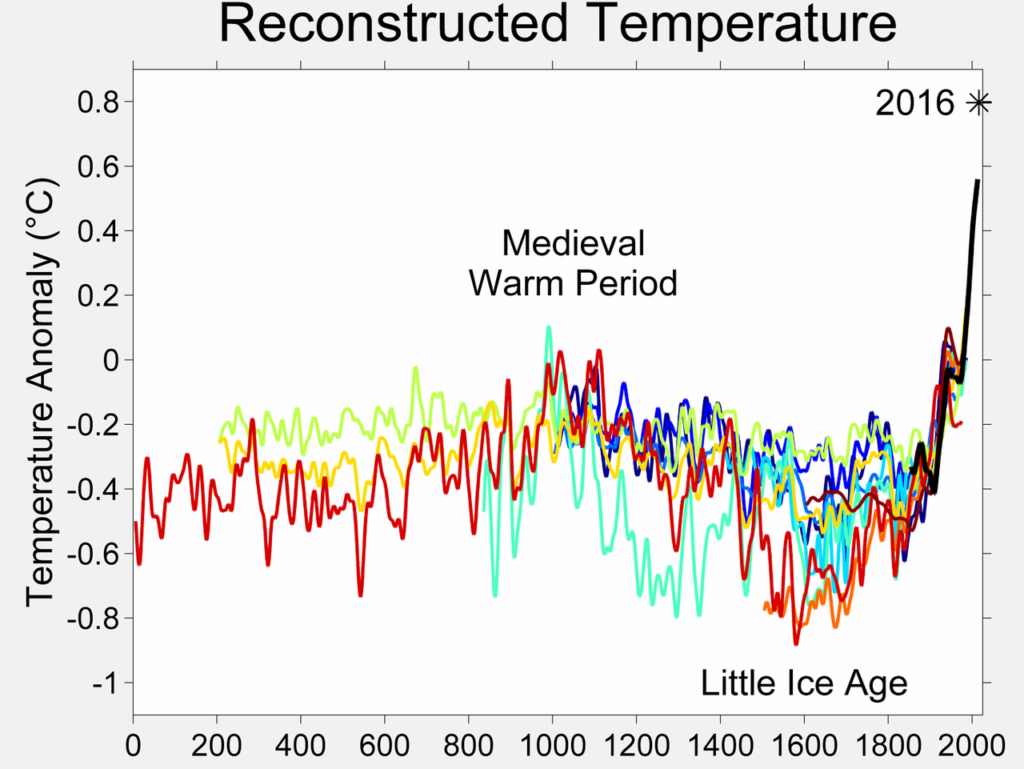Let’s have an honest, scientific conversation about climate change…and let’s base our policy proposals on facts. Sadly the discussion about this topic has become an absolute minefield of logical fallacies. We need to cut through them and try to get to the truth.
The Fallacies
How many times have you heard the mantra that “ninety-seven percent of scientists agree” about climate change? That’s the argument from authority fallacy (and it isn’t true anyway).
How many times have we heard from those who doubt the consensus view that we don’t know enough about the climate to come to any conclusions at all? That’s the argument from ignorance fallacy.
How about the slander of skeptics as “deniers” or “anti-science” and so-forth? That’s called the ad-hominem fallacy (attacking the person instead of the argument).
How about the argument that the earth is going to end in twelve years, so we had better act now? That’s the appeal to consequences fallacy, which is used to distract us from having an intelligent, adult discussion on the topic.
How about the use of heart-wrenching, out-of-context photos of suffering animals or melting ice to try and force actions that are unsupported by the facts? That’s the appeal to emotion fallacy.
And what about the claim that those of us who doubt the fear-mongers must hate the environment and don’t want clean air and water? Yeah, that’s a classic straw man fallacy. Nobody wants dirty air and water. Let’s deal with each others’ real beliefs, not false caricatures of them.
Now, with all of that out of the way, we can start to actually consider the topic at hand.
The Hockey Stick
You’ve probably seen a thousand variants of this graph:

It’s called the “hockey stick graph” because it shows a long period of relatively stable temperatures, followed by a sharp increase after we reach the industrial era and start burning fossil fuels. It sort-of looks like a hockey stick. And if the data presented in this graph is accurate, it would seem to indicate that we were in pretty serious trouble.
But there are a few things we should be aware of before we take it as gospel truth.
First and foremost, we’re looking at a graph that presents both temperature reconstructions from proxy data (almost all of the lines) and actual temperature records (only the black line). The proxies likely don’t have the same kind of resolution as the modern records, and it’s certainly possible that some dips and spikes have been smoothed out. We’re linking together apples and oranges and treating them as a single, cohesive set of data.
Second, I can tell at a glance that the data is inaccurate. It doesn’t seem to show the Roman warm period at all, which should be a period of unusually warm temperatures from the beginning of the graph (it started around 250 B.C.) up ’til about A.D. 400. And while it does show the medieval warm period from about A.D. 950 to 1250, and even labels it for us, it badly underestimates its severity. We know about these two warm periods from history. These both occurred well after the development of writing and agricultural record keeping, so we can literally just read about them from the people who lived through them. If the temperature reconstructions consistently don’t align with recorded history, then we know reconstructions cannot be trusted.
Third, note that the reconstruction data that extends into modern times (ignoring the black line for a minute) shows our current temperatures roughly equal to those in the medieval warm period. So if the reconstruction methods are calculating values about 0.5 degrees Celsius below what the actual instruments show during a warm period, perhaps they similarly underestimated the medieval warm period by about that amount. That would explain that discrepancy, yes. It would also show that today’s temperatures aren’t particularly unusual.
Fourth, note that some of the reconstructions show fairly consistent warming from about 1600 to present. Look, for example, at the red and orange. If the world has been seeing significant warming since then — more than two-hundred years before we were burning fossil fuels in large amounts — then it is unlikely that fossil fuels are the main driver of this process.
Carbon Dioxide
The underlying theory behind climate change (formerly global warming) is that carbon gasses in the atmosphere — primarily carbon dioxide (CO2) — act as greenhouse gasses, which trap some of the sun’s energy in our atmosphere. This causes it to warm.
It is true that we have released a lot of CO2 into the atmosphere since the beginning of the industrial revolution. And it is true that CO2 is a greenhouse gas. What this means is that the basic theory is correct. This is indisputable. Anybody who says the climate isn’t changing at all because of human activity needs to study more. (Although it’s also pretty silly to call CO2 a pollutant — something that every oxygen breathing animal exhales naturally, and every oxygen-creating plant consumes as food, cannot be a “pollutant.”)
But there are serious questions about how much of our changing climate is due to human activity…especially since, even with the recorded temperature increases in the last couple hundred years, the climate actually hasn’t changed that much. The purported dire consequences of carbon release — more severe droughts and hurricanes, more storms, rising seas — pretty much aren’t happening.
Don’t pay attention to perception — we hear about these things a lot more because of modern mass media and the Internet, and political proponents of radical climate change policies latch on to these and use them to their advantage. But look at the data. There has been no significant change in storm or drought incidence or severity. And while some studies do show that the seas are rising, the amount by which they are rising diminishes rapidly when you correct that raw data for subsidence (i.e., the places where the land is sinking due to tectonic movement and other factors).
Let’s do some simple critical thinking here. We’ve almost doubled the amount of CO2 in the atmosphere, from about 200 parts-per-million (ppm) to about 400 ppm. Even so, that means that only 1/2,500th of the atmosphere is CO2…only 0.04%. On the other hand, water vapor (H2O) — a greenhouse gas more potent than CO2 — makes up about 4% of the atmosphere. That’s almost exactly a hundred times more.
Is water also a pollutant? Is human water use (e.g., artificial lakes and ponds, open air treatment facilities and reservoirs, swimming pools, and so on) a dire threat to humanity’s future? Of course not. But if you believe the hype about CO2, you should believe it about water too…maybe even a hundred times worse.
We should significantly reduce our carbon emissions. I talk about this in the clean air and water area. But let’s not overestimate how dire a threat it is, and let’s not upend our economy (and the whole of modern civilization) to do it. The world is not going to end in twelve years (or twenty years, or a hundred years, or a thousand years). Let’s take reasonable steps to reduce emissions but let’s not do it on the basis of fear and nonsense.
Furthermore, we must be suspicious of big-government plans in this and other areas proposed by people who openly identify as socialists. They are generally just using this issue (and others) to assert central control of the economy for their own reasons.
